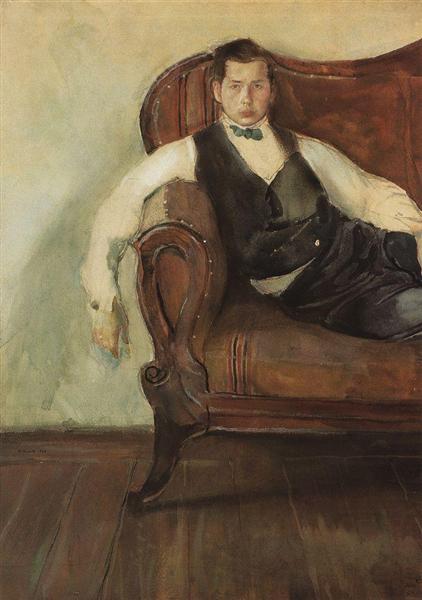Описание
In the work “Self-Portrait” from 1898, Konstantin Somov presents himself not just as an artist, but as a fascinating figure in the context of Russian Symbolism and, more broadly, turn-of-the-century art. Looking at this painting, it is impossible not to notice the deep introspection that emanates from the image. Somov chose to depict himself in a moment of contemplation and elegance, capturing a mood that feels both personal and universal.
The composition of the work is notable for its balance and symmetry. The artist is placed in the center of the canvas, like a kind of island in a sea of textures and colors that surround him. The pose is relaxed but charged with meaning; his gaze is not simply towards the viewer, but he seems to be lost in his own thoughts. This choice invites the viewer to enter into a deeper connection with the artist, suggesting that the act of painting a self-portrait is also an act of self-reflection.
The use of colour in this work is meticulously strategic. Somov uses a palette that oscillates between soft and dark tones, with warm blues and browns predominating, giving the painting a melancholic, almost nostalgic atmosphere. The subtle nuances not only accentuate the three-dimensionality of her face, but also help to create a setting that evokes a sense of specific time and space. The carefully rendered folds of her clothing and the drape of the fabric suggest a quest for perfection in representation, an echo of the decorative air of art nouveau that would influence her contemporary.
As for the characters, the uniqueness of the self-portrait lies in the fact that there are no other human beings present: the focus is exclusively on Somov. This decision highlights the artist's individuality, suggesting that the most intense relationship that can be explored is the relationship with himself. The loneliness implied in this choice can be interpreted not only as a feature of his own personal life, but also as a reflection of the artistic experience in general, where the creator is often faced with his own introspection.
It is interesting to note that Somov, throughout his career, distanced himself from the more aggressive tendencies of the art of his time, embracing instead symbolism, which sought to express ideas and emotions through more subtle forms and colours. This self-portrait is a rich example of that sensibility, depicting not only an individual, but also the fragility and complexity of the human being in a period of great cultural and social change.
Somov's style, often described as ornamental and decorative, is present here in the treatment of the background and the atmosphere surrounding the figure, which seems to flow in an almost ethereal manner. The painterly qualities in this work reveal an influence of symbolism and art nouveau, two currents in which Somov took an active part, reflecting his desire to unite art and aesthetics into a coherent whole.
When analyzing "Self-Portrait - 1898", we find ourselves before a work that is not only a window into the artist's identity, but also a representation loaded with cultural and emotional symbolism. Somov offers us a portrait that invites contemplation and interpretation, a work that transcends its time and continues to resonate in the continuous search of the human being to find himself. In this sense, the self-portrait becomes a universal experience that speaks of the eternity of artistic introspection.
KUADROS ©, a famous painting on your wall.
Hand-made oil painting reproductions, with the quality of professional artists and the distinctive seal of KUADROS ©.
Painting reproduction service with satisfaction guarantee. If you are not completely satisfied with the replica of your painting, we will refund 100% of your money.

